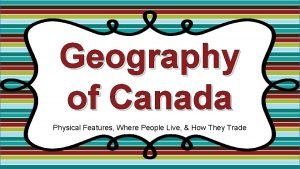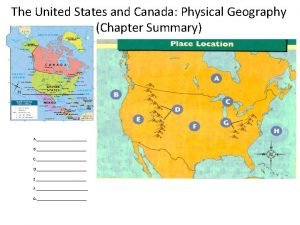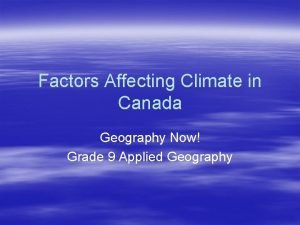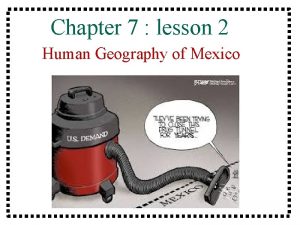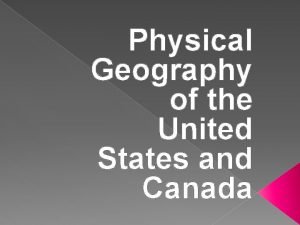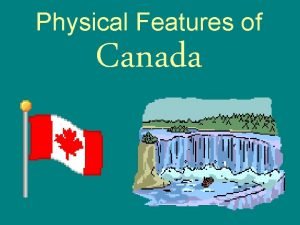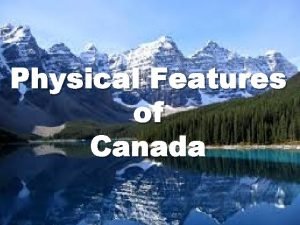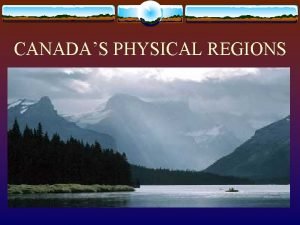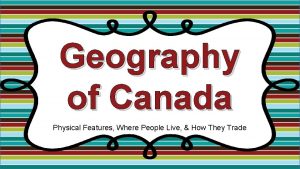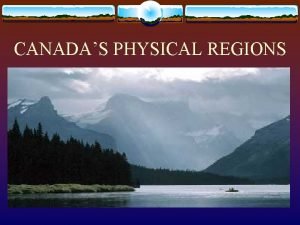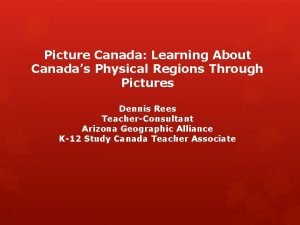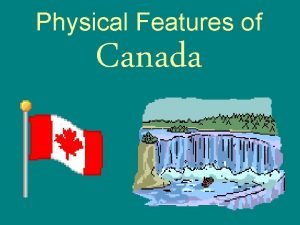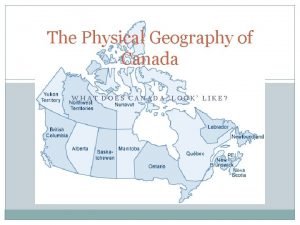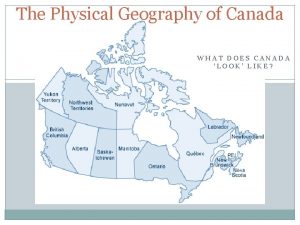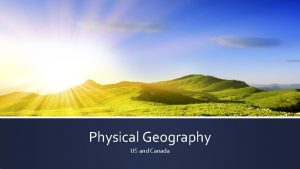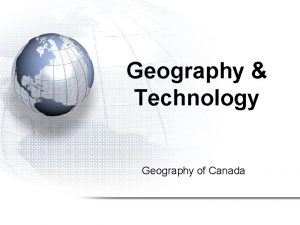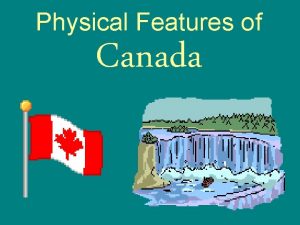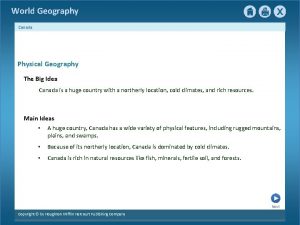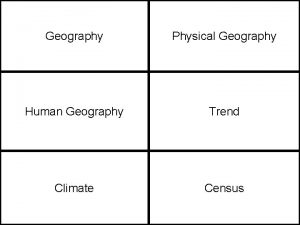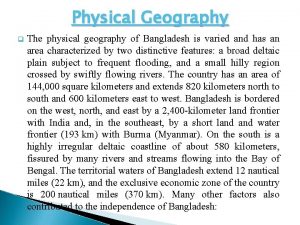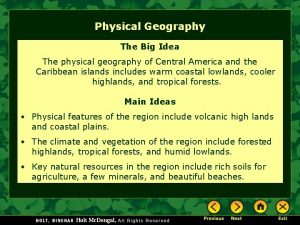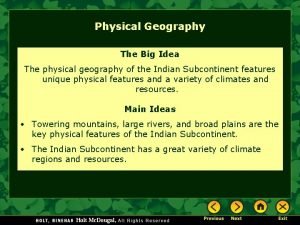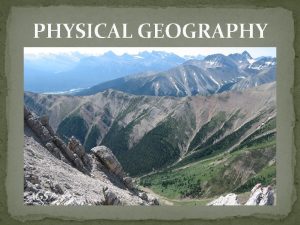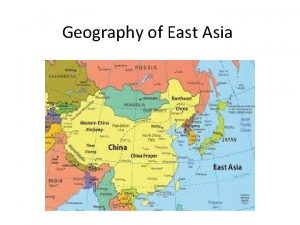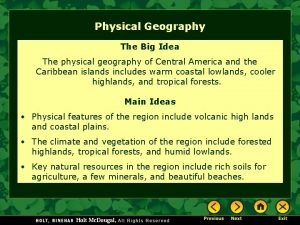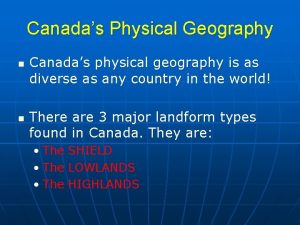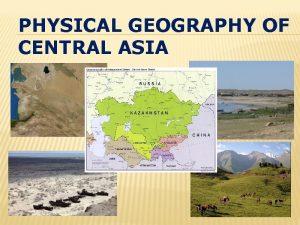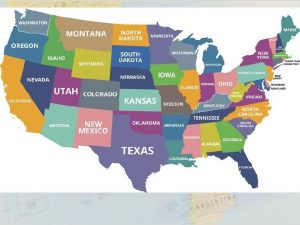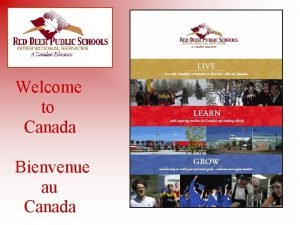Physical Geography of The U S Canada EQ

























- Slides: 25

Physical Geography of The U. S. & Canada EQ: Discuss main geographic landforms of the U. S. & Canada and examine varied landforms in relation to their lifestyles.

Places & Terms for Discussion Appalachian Mountains Great Plains Canadian Shield Rocky Mountains Great Lakes Mackenzie River Prevailing Westerlies Everglades Lock St. Lawrence Seaway

Physical Map Image of North America

Political U. S. Map

Political Look at Canada

Landforms & Resources Vast Lands: Canada ranks 2 nd , behind Russia, and the United States 3 rd in total land area. Together they fill 1/8 of the land surface of the earth. Both countries are rich in natural resources. Fertile soils Ample water supplies Vast forests Variety of minerals All of these have attracted immigrants from around the world and allowed both countries to develop into global powers

Natural Resources Examine the map of the U. S. and Canada’s resources on pg. 120 and answer the following questions: 1) What resources seem to appear the most in the U. S. ? 2) Which energy resource is more widespread in Canada than in the U. S. ? Why is this? 3) What are some advantages Canada and the U. S. may have as a result of their abundant resources?


Landforms & Resources Many Varied Landforms Eastern Lowlands: Flat coastal plain runs along the Atlantic Ocean & Gulf of Mexico. (Atlantic Coastal Plain) Appalachian Highlands: Gently sloping Appalachian Mountains. Have been eroded over time. Considered to be over 400 million years old. Interior Lowlands: Flattened by glaciers thousands of years ago. Terrain varies between lowlands, hills, lots of lakes & rivers. 3 subregions: Interior Plains / Great Plains / Canadian Shield

Landforms & Resources Western Mountains, Plateaus, & Basins: Rocky Mountains range 3, 000 miles from Alaska south to New Mexico. Thought to be around 80 million years old. Continental Divide: marks the separation between rivers flowing eastward & westward Mt. Mc. Kinley: North America’s highest peak at 20, 300 ft is in Alaska.

Landforms & Resources Oceans & Waterways: Great Lakes: Huron – Ontario – Michigan – Erie – Superior along with the St. Lawrence River form one of the worlds most important shipping routes. Mississippi River: The continents longest and busiest river system. Mackenzie River: Canada’s longest river

Landforms The U. S. and Canada have many different types of landforms. Refer to the map on pg. 118 and answer the following questions: 1) What are two U. S. states and two Canadian provinces found in the Great Plains region? 2) Which U. S. state and which Canadian province seem to have the most diverse physical landforms?


Features of Canadian and U. S. Landforms Rocky Mountains Great Plains Canadian Shield Appalachian Mountains Western mountain chain Mostly treeless area Rocky and Flat Eastern mountain chain Extends 3, 000 miles from New Mexico to Alaska 4, 000 feet above sealevel Lies in northeast Canada 1, 600 miles from Alabama to Newfoundland Its highest point is called the “Continental Divide” Runs from southern Texas up through southern Canada Covers about 1. 8 million square miles Includes the Green, Catskill, and Smoky Mountains 80 million years old Its fertile soil allows crops to grow in abundance Encircles the Hudson Bay 400 million years old

Climate & Vegetation Almost every climate type can be found in the U. S. because it extends over such a large area. Canada’s cold climate is related to its location in the far northern latitudes. Some places there is permafrost, or permanently frozen ground. Prevailing Westerlies, winds that blow from west to east in the middle latitudes, keep the summers warm and the winters mild along the Pacific Coast and coastal mountains.

Climate & Vegetation The Everglades, found in southern Florida, has a tropical wet and dry climate is a huge swamplandthat covers some 4, 000 square miles.

North America Climate Map

North America Vegetation Map

Human – Environment Interaction Settlement: First inhabitants were nomads who moved from place to place. Archaeologists believe they migrated from Asia over the Beringia land bridge. Hunting & Gathering was their Primary method of food production before they began to cultivate crops.

Human – Environment Interaction Overcoming Distances When the Europeans arrived and settled on the east coast they began to move inland. They carved out trails including the Oregon and Santa Fe trails. They built networks of canals and North America’s most important deepwater ship route – the St. Lawrence Seaway. Ships were raised and lowered some 600 feet by a series of locks, (page 129)sections of waterway with closed gates where water levels are raised and lowered. The seaway enables huge, oceangoing vessels to sail into the heartland of North America.

Human – Environment Interaction The Transcontinental Railroad was completed across the U. S. in 1869. A trans-Canada railroad, from Montreal to British Columbia, was completed in 1885. These railroads help to carry goods and passengers cross-country promoting economic development and national unity. (much like technology has done for the world today) In the early 20 th century with the development of the automobile brought about the extensive highway systems. U. S. has about 4 million miles of roads. Canada has about 560, 000 miles of roads

Interstate Highway Map

Transcontinental Railroad Map

Review Mountain Ranges Rocky Mountains Appalachian Mountains Resources Both U. S. and Canada have huge mineral and fossil fuel resources Forest lands cover about 1/3 of the U. S. and ½ of Canada Climate & Vegetation Canada’s climates and vegetation are related to it’s far northern location. The U. S. includes regions that are in almost every climate and vegetation zone Major Water ways Mississippi-Missouri-Ohio river system Mackenzie River Columbia River Rio Grande River Colorado River St. Lawrence Seaway Human – Environment Interaction Movement westward altered the land in both the U. S. and Canada Transportation networks helped develop the land economy of the region.

Physical Map Activity (Day 2) Artist and Materials Manager are to Divide Class into draw and color the map groups of 4. Historian and Recorder are to Artist answer the following questions at Materials manager the bottom of the map. Historian Write question and answer to the Recorder following at bottom of map. Students are to What landforms are shared by the U. S. and Canada? construct a large physical map of the U. S. What makes the St. Lawrence Seaway so important to the U. S. economy? and Canada. What are some of the major obstacles that had to be overcome in uniting the U. S. when building railroads and highways?
 Canada physical features
Canada physical features The physical geography of the united states and canada
The physical geography of the united states and canada Geography now canada
Geography now canada Chapter 7 lesson 2 social studies
Chapter 7 lesson 2 social studies United states and canada physical map
United states and canada physical map Great lakes connected to ocean
Great lakes connected to ocean Important physical features of canada
Important physical features of canada Physical regions of canada
Physical regions of canada Physical features in canada
Physical features in canada What is a physical region
What is a physical region Physical regions in canada
Physical regions in canada Important physical features of canada
Important physical features of canada How to write an frq for ap human geography
How to write an frq for ap human geography 5 themes of geography ap human geography
5 themes of geography ap human geography Stateless nation
Stateless nation Hình ảnh bộ gõ cơ thể búng tay
Hình ảnh bộ gõ cơ thể búng tay Lp html
Lp html Bổ thể
Bổ thể Tỉ lệ cơ thể trẻ em
Tỉ lệ cơ thể trẻ em Gấu đi như thế nào
Gấu đi như thế nào Tư thế worm breton
Tư thế worm breton Hát lên người ơi
Hát lên người ơi Môn thể thao bắt đầu bằng chữ đua
Môn thể thao bắt đầu bằng chữ đua Thế nào là hệ số cao nhất
Thế nào là hệ số cao nhất Các châu lục và đại dương trên thế giới
Các châu lục và đại dương trên thế giới Công thức tính độ biến thiên đông lượng
Công thức tính độ biến thiên đông lượng
